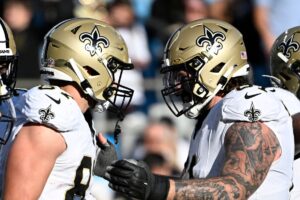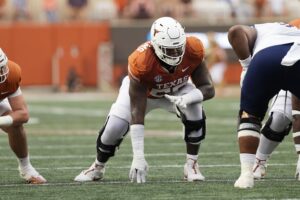For Chicago Bears fans, signs of progress from Justin Fields are tantamount to actual wins at this point in a lost season. See, because if he progresses enough to look like “the guy” next season, then the season wasn’t lost. Right? Not quite, and it doesn’t have anything to do with the Bears being officially eliminated from the playoffs following their loss on Monday.
Many viewed the Bears postseason chances like quarks. We knew they existed but they are so minuscule that we could never be sure.
With Fields, the data can pull you in different directions depending on what you are looking at.
Chicago Bears: The Pitfalls of Trying to Measure Justin Fields’ Progress
Like a Band-Aid
There have been plenty of poor statistics to come out of Fields’ season. So much so that Kevin Siefert wrote about how the 11th-overall pick in last April’s NFL Draft compares to some of the worst quarterbacks to draw starts in league history. It has become the perfect “told you so” memento for those ready to bail after 10 starts in 12 games.
At the heart of the article is QBR, a metric in which Fields – and Zach Wilson whom the article only mentions in passing – is on pace for historic numbers of the bad kind. It also mentions his fumbles, his tendency to hold onto the ball, and, in general, the wild swings in his “wow” plays.
All of those are big areas of concern for any quarterback, let alone one selected just outside of the top-10.
In the end, the article is simply suggesting that while Fields certainly can prove to be better than his numbers suggest, it would seem very unlikely given the historical data. And Siefert isn’t alone. A simple search on Twitter will bring up any number of graphics and charts depicting just how bad Fields has been.
It is almost as if the loudest voices demanding Fields be given a shot – even after it was known he wasn’t given a fair shake in the leadup to the season – are now trying to go in the opposite direction.
I thought @justnfields played really well overall last night:
-less sacks
-play faster in pocketBut I really like just the subtle nuance of this play—doing plays like this consistently—on top of the it play talent—2022!! @ChicagoBears pic.twitter.com/UN09UkWA19
— Dan Orlovsky (@danorlovsky7) December 21, 2021
A Flawed Argument
Immediately, the article creates a false comparison based solely on the (many poor) results. Sure, it attempts to soften the blow by explaining some of the few things the Bears have done to help or the many they’ve done to hurt. But it still fails to encapsulate two critical pieces that go on to shape the entire narrative of the piece.
First, Fields left Ohio State far more accomplished than any of the three washouts mentioned in Jimmy Clausen, Blaine Gabbert, and Josh Rosen.
Both Gabbert and Rosen were each selected with the 10th pick by the Jacksonville Jaguars and Arizona Cardinals, respectively. Clausen was a second-round pick by the Carolina Panther but was one of the top-rated passers in his class as well.
The issue is Gabbert played for the Jacksonville Jaguars who might be the face of tumultuousness in the NFL. Rosen’s Cards wound up getting the first-overall selection and a new head coach in Kliff Kingsbury who had eyes on one Kyler Murray. Clausen got the heave-ho in favor of the Cam Newton phenomenon.
All three of their drafting franchises underwent coaching changes the next season, something that would count as working against Fields.
That is where the nuance of this discussion gets lost. There are many factors at play here. Not the least of which is the perception of Fields relative to the others that Siefert’s piece highlighted.
[pickup_prop id=”17557″]
Perception vs. Reality
There weren’t many proclaiming those three to be saviors for a franchise. At least, not as much as they were the best of what was a weak class. Fields did experience a slide but it was believed to mostly be related to his being diagnosed with epilepsy; a condition he said he’s dealt with for years with no impact on his play.
Even with that, he tested off of the charts both physically and mentally.
There is also that mention of Wilson. The article states that only the aforementioned three passers were the only ones to put up worse numbers than Fields’ if the season ended today.
But it also clearly states that Wilson, who has also made 10 starts, has a worse QBR.
The reasons behind Wilson (and to some extent Trevor Lawrence) are as multi-faceted as the faces behind the criticisms of Fields.
Numerous counter-arguments shine a positive light on what Fields has done. There is his big-time throw percentage and the percentage of his passes thrown beyond the first-down marker. Or the video above from Dan Orlovsky speaking of the subtle growth Fields displayed in that Monday Night Football loss.
Highest percentage of wide receiver routes where the player was deemed to be open (PFF)
1. Chiefs (54%)
2. Packers (49%)
3. Rams (48%)
…
32. Bears (36%)— Ian Hartitz (@Ihartitz) December 21, 2021
Wait and See on Fields’ Progress
In the end, Fields is a case where we need to wait and see. He didn’t come into a situation that anyone felt was conducive to developing a quarterback. Mitchell Trubisky flamed out in this town and Nick Foles and Andy Dalton looked less than serviceable under Matt Nagy. There was no chance a rookie was coming in and overcoming all the ails we witnessed from this regime. At the same time, the fumbles and internal clock are Fields’ issues to correct. Those are things that can be corrected, though. The innate abilities he’s shown cannot.
And yet, “innate abilities” don’t win enough games. If the Bears can’t help Fields reach his potential, they’ll be in the same position they have been for decades. That is regardless of who they hire to be the next coach.
He certainly isn’t reaching that potential this season under these circumstances. And any new scheme is going to have an adjustment period all its own. That means there could be more bumps along the way.
We won’t truly know how good (or bad) he will be until he gets a fresh start under a staff that isn’t essentially full of lame ducks.
Main Photo:
Embed from Getty Images






